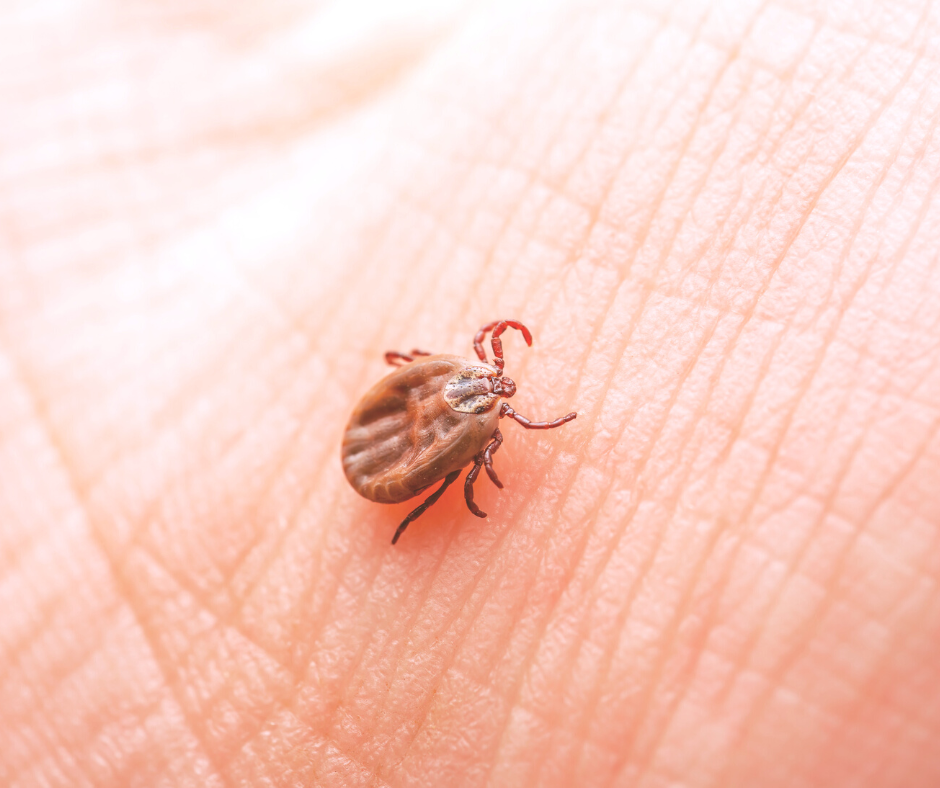During the fall, kids and pets love to play in piles of leaves, but did you know that fallen leaves are tick habitats? For most of us, when we think of tick avoidance, we think of tall grass, not leaves. Adult ticks are actually the most active in the fall. This is because of the life cycle a tick goes through from egg, larvae, nymph, to adult. This happens over the course of about two years, and they need a new host at each stage in their life cycle. In the fall of the second year, the adult ticks emerge and look for their host, and they will remain active until the ground is frozen.
When ticks feed on their host, they insert their feeding tube and secrete saliva that has anesthetic properties. The tick then feeds on the blood of the host for typically a few days. During this time, the tick continues to secrete some saliva. If the saliva contains a pathogen, the pathogen is transmitted to the host. How do ticks get these pathogens in the first place? By feeding on another host that has that pathogen during a previous meal in another stage of its life.
Ticks can transmit Lyme disease and many other tick-borne illnesses that are just as serious and debilitating. According to the Global Lyme Alliance, “The majority of people who develop tick-borne diseases came in contact with the tick that made them sick right in their own backyards”. How much of a threat is Lyme disease? It’s been documented in all 50 states, as well as 65 different countries, and current diagnostics miss up to 60% of acute cases.
Ways you can prevent contracting a tick-borne illness this fall:
- Remove leaf litter around your property.
- Wear a tick repellent, closed toe shoes, and clothing that covers your body when raking leaves.
- When walking in nature, through leaves, or tall grass tuck you pant legs into your socks. This will keep the ticks mostly on the outside of your clothing and away from your skin.
- Thoroughly check yourself, kids, and pets for ticks after spending time outdoors.
- Take a shower, change, and wash your clothes when your done spending time outside.
- Do not play in leaf piles or toss leaves into the air.
- Avoid sitting directly on the ground.
- Avoid walking through brush, leaves, tall grass, or vegetation.
- Treat your pets.
To learn more about Lyme and other tick-borne illnesses and how our testing can help, schedule your consultation today, 717-660-2320.
References
| bedfordma. (n.d.). Retrieved October 16, 2022, from https://www.bedfordma.gov/sites/g/files/vyhlif6866/f/file/file/october_article_-_ticks_in_leaves.pdf\
Gla, A. A. (n.d.). Fall Tick Season is in Full Swing. Retrieved October 16, 2022, from https://www.globallymealliance.org/blog/fall-tick-season-is-in-full-swing-prevention-tips
How ticks spread disease | CDC. (2020, September 21). Centers for Disease Control and Prevention. Retrieved October 16, 2022, from https://www.cdc.gov/ticks/life_cycle_and_hosts.html
Lyme Disease Facts and Statistics. (2022, July 22). Bay Area Lyme Foundation. Retrieved October 16, 2022, from https://www.bayarealyme.org/about-lyme/lyme-disease-facts-statistics/
Preventing tick bites on people | CDC. (2020, July 1). Centers for Disease Control and Prevention. Retrieved October 16, 2022, from https://www.cdc.gov/ticks/avoid/on_people.html

